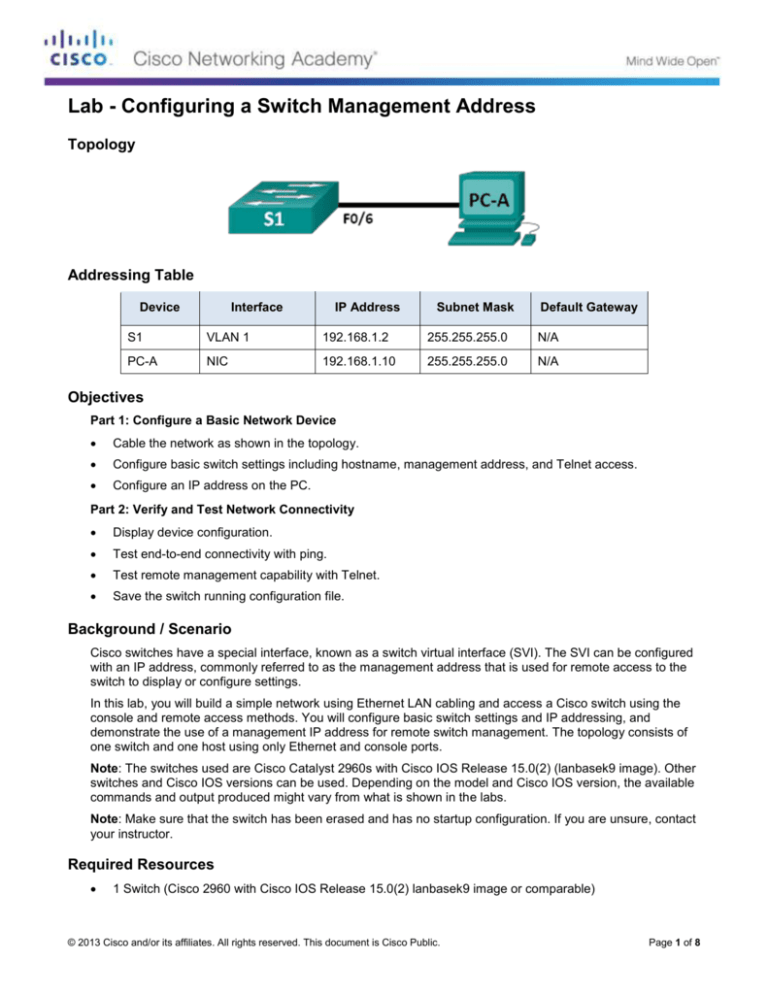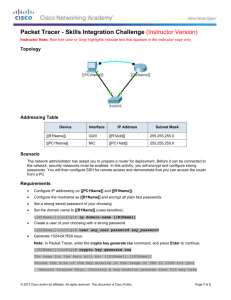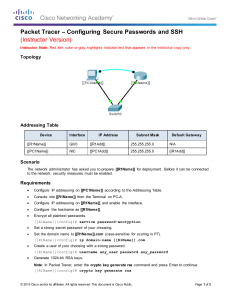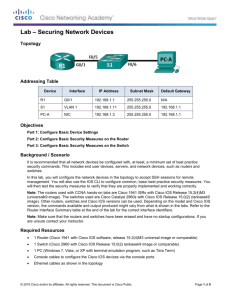
Lab - Configuring a Switch Management Address
Topology
Addressing Table
Device
Interface
IP Address
Subnet Mask
Default Gateway
S1
VLAN 1
192.168.1.2
255.255.255.0
N/A
PC-A
NIC
192.168.1.10
255.255.255.0
N/A
Objectives
Part 1: Configure a Basic Network Device
Cable the network as shown in the topology.
Configure basic switch settings including hostname, management address, and Telnet access.
Configure an IP address on the PC.
Part 2: Verify and Test Network Connectivity
Display device configuration.
Test end-to-end connectivity with ping.
Test remote management capability with Telnet.
Save the switch running configuration file.
Background / Scenario
Cisco switches have a special interface, known as a switch virtual interface (SVI). The SVI can be configured
with an IP address, commonly referred to as the management address that is used for remote access to the
switch to display or configure settings.
In this lab, you will build a simple network using Ethernet LAN cabling and access a Cisco switch using the
console and remote access methods. You will configure basic switch settings and IP addressing, and
demonstrate the use of a management IP address for remote switch management. The topology consists of
one switch and one host using only Ethernet and console ports.
Note: The switches used are Cisco Catalyst 2960s with Cisco IOS Release 15.0(2) (lanbasek9 image). Other
switches and Cisco IOS versions can be used. Depending on the model and Cisco IOS version, the available
commands and output produced might vary from what is shown in the labs.
Note: Make sure that the switch has been erased and has no startup configuration. If you are unsure, contact
your instructor.
Required Resources
1 Switch (Cisco 2960 with Cisco IOS Release 15.0(2) lanbasek9 image or comparable)
© 2013 Cisco and/or its affiliates. All rights reserved. This document is Cisco Public.
Page 1 of 8
Lab - Configuring a Switch Management Address
1 PC (Windows 7, Vista, or XP with terminal emulation program, such as Tera Term)
Console cables to configure the Cisco IOS devices via the console ports
Ethernet cables as shown in the topology
Part 1: Configure a Basic Network Device
In Part 1, you will set up the network and configure basic settings, such as hostnames, interface IP
addresses, and passwords.
Step 1: Cable the network.
a. Cable the network as shown in the topology.
b. Establish a console connection to the switch from PC-A.
Step 2: Configure basic switch settings.
In this step, you will configure basic switch settings, such as hostname and configuring an IP address for the
SVI. Assigning an IP address on the switch is only the first step. As the network administrator, you must
specify how the switch will be managed. Telnet and Secure Shell (SSH) are two of the most common
management methods; however, Telnet is a very insecure protocol. All information flowing between the two
devices is sent in plain text. Passwords and other sensitive information can be easily looked at if captured by
a packet sniffer.
a. Assuming the switch had no configuration file stored in nonvolatile random-access memory (NVRAM),
you will be at the user EXEC mode prompt on the switch with a prompt of Switch>. Enter privileged
EXEC mode.
Switch> enable
Switch#
b. Verify a clean configuration file with the show running-config privileged EXEC command. If a
configuration file was previously saved, it will have to be removed. Depending on the switch model and
IOS version, your configuration may look slightly different. However, there should be no configured
passwords or IP address set. If your switch does not have a default configuration, ask your instructor for
help.
c.
Enter global configuration mode and assign the switch hostname.
Switch# configure terminal
Switch(config)# hostname S1
S1(config)#
d. Configure the switch password access.
S1(config)# enable secret class
S1(config)#
e. Prevent unwanted Domain Name System (DNS) lookups.
S1(config)# no ip domain-lookup
S1(config)#
f.
Configure a login message-of-the-day (MOTD) banner.
S1(config)# banner motd #
Enter Text message. End with the character ‘#’.
Unauthorized access is strictly prohibited. #
© 2013 Cisco and/or its affiliates. All rights reserved. This document is Cisco Public.
Page 2 of 8
Lab - Configuring a Switch Management Address
g. Verify your access setting by moving between modes.
S1(config)# exit
S1#
S1# exit
Unauthorized access is strictly prohibited.
S1>
What shortcut keys are used to go directly from global configuration mode to privileged EXEC mode?
____________________________________________________________________________________
h. Return to privileged EXEC mode from user EXEC mode.
S1> enable
Password: class
S1#
Note: Password will not show up on screen when entering.
i.
Enter global configuration mode to set the SVI IP address to allow remote switch management.
S1# config t
S1#(config)# interface vlan 1
S1(config-if)# ip address 192.168.1.2 255.255.255.0
S1(config-if)# no shut
S1(config-if)# exit
S1(config)#
j.
Restrict console port access. The default configuration is to allow all console connections with no
password needed.
S1(config)# line
S1(config-line)#
S1(config-line)#
S1(config-line)#
S1(config)#
k.
con 0
password cisco
login
exit
Configure the virtual terminal (VTY) line for the switch to allow Telnet access. If you do not configure a
VTY password, you will not be able to Telnet to the switch.
S1(config)# line vty 0 4
S1(config-line)# password cisco
S1(config-line)# login
S1(config-line)# end
S1#
*Mar 1 00:06:11.590: %SYS-5-CONFIG_I: Configured from console by console
© 2013 Cisco and/or its affiliates. All rights reserved. This document is Cisco Public.
Page 3 of 8
Lab - Configuring a Switch Management Address
Step 3: Configure an IP address on PC-A.
a. Assign the IP address and subnet mask to the PC, as shown in the Addressing Table on page 1. The
procedure for assigning an IP address on a PC running Windows 7 is described below:
1) Click the Windows Start icon > Control Panel.
2) Click View By: > Category.
3) Choose View network status and tasks > Change adapter settings.
4) Right-click Local Area Network Connection and select Properties.
5) Choose Internet Protocol Version 4 (TCP/IPv4), click Properties > OK.
6) Click the Use the following IP address radio button and enter the IP address and subnet mask.
Part 2: Verify and Test Network Connectivity
You will now verify and document the switch configuration, test end-to-end connectivity between PC-A and
S1, and test the remote management capability of the switch.
Step 1: Display the S1 device configuration.
a. Return to your console connection using Tera Term on PC-A to display and verify your switch
configuration by issuing the show run command. A sample configuration is shown below. The settings
you configured are highlighted in yellow. The other configuration settings are IOS defaults.
S1# show run
Building configuration...
Current configuration : 1508 bytes
!
! Last configuration change at 00:06:11 UTC Mon Mar 1 1993
!
version 15.0
no service pad
service timestamps debug datetime msec
service timestamps log datetime msec
no service password-encryption
!
hostname S1
!
boot-start-marker
boot-end-marker
!
enable secret 4 06YFDUHH61wAE/kLkDq9BGho1QM5EnRtoyr8cHAUg.2
!
no aaa new-model
system mtu routing 1500
!
!
no ip domain-lookup
!
spanning-tree mode pvst
© 2013 Cisco and/or its affiliates. All rights reserved. This document is Cisco Public.
Page 4 of 8
Lab - Configuring a Switch Management Address
spanning-tree extend system-id
!
vlan internal allocation policy ascending
!
!
interface FastEthernet0/1
!
interface FastEthernet0/2
<output omitted>
interface FastEthernet0/24
!
interface GigabitEthernet0/1
!
interface GigabitEthernet0/2
!
interface Vlan1
ip address 192.168.1.2 255.255.255.0
!
ip http server
ip http secure-server
!
banner motd ^C
Unauthorized access is strictly prohibited. ^C
!
line con 0
password cisco
login
line vty 0 4
password cisco
login
line vty 5 15
login
!
end
b. Verify the status of your SVI management interface. Your VLAN 1 interface should be up/up and have an
IP address assigned. Notice that switch port F0/6 is also up because PC-A is connected to it. Because all
switch ports are initially in VLAN 1, by default, you can communicate with the switch using the IP address
you configured for VLAN 1.
S1# show ip interface brief
Interface
Vlan1
FastEthernet0/1
FastEthernet0/2
FastEthernet0/3
FastEthernet0/4
FastEthernet0/5
FastEthernet0/6
IP-Address
192.168.1.2
unassigned
unassigned
unassigned
unassigned
unassigned
unassigned
OK?
YES
YES
YES
YES
YES
YES
YES
Method
manual
unset
unset
unset
unset
unset
unset
© 2013 Cisco and/or its affiliates. All rights reserved. This document is Cisco Public.
Status
up
down
down
down
down
down
up
Protocol
up
down
down
down
down
down
up
Page 5 of 8
Lab - Configuring a Switch Management Address
FastEthernet0/7
FastEthernet0/8
FastEthernet0/9
FastEthernet0/10
FastEthernet0/11
FastEthernet0/12
FastEthernet0/13
FastEthernet0/14
FastEthernet0/15
FastEthernet0/16
FastEthernet0/17
FastEthernet0/18
FastEthernet0/19
FastEthernet0/20
FastEthernet0/21
FastEthernet0/22
FastEthernet0/23
FastEthernet0/24
GigabitEthernet0/1
GigabitEthernet0/2
unassigned
unassigned
unassigned
unassigned
unassigned
unassigned
unassigned
unassigned
unassigned
unassigned
unassigned
unassigned
unassigned
unassigned
unassigned
unassigned
unassigned
unassigned
unassigned
unassigned
YES
YES
YES
YES
YES
YES
YES
YES
YES
YES
YES
YES
YES
YES
YES
YES
YES
YES
YES
YES
unset
unset
unset
unset
unset
unset
unset
unset
unset
unset
unset
unset
unset
unset
unset
unset
unset
unset
unset
unset
down
down
down
down
down
down
down
down
down
down
down
down
down
down
down
down
down
down
down
down
down
down
down
down
down
down
down
down
down
down
down
down
down
down
down
down
down
down
down
down
Step 2: Test end-to-end connectivity.
Open a command prompt window (cmd.exe) on PC-A by clicking the Windows Start icon and enter cmd into
the Search for programs and files field. Verify the IP address of PC-A by using the ipconfig /all command.
This command displays the PC hostname and the IPv4 address information. Ping PC-A’s own address and
the management address of S1.
a. Ping your own PC-A address first.
C:\Users\NetAcad> ping 192.168.1.10
Your output should be similar to the following screen:
© 2013 Cisco and/or its affiliates. All rights reserved. This document is Cisco Public.
Page 6 of 8
Lab - Configuring a Switch Management Address
b. Ping the SVI management address of S1.
C:\Users\NetAcad> ping 192.168.1.2
Your output should be similar to the following screen. If ping results are not successful, troubleshoot the
basic device configurations. You should check both the physical cabling and IP addressing, if necessary.
Step 3: Test and verify remote management of S1.
You will now use Telnet to remotely access the switch S1 using the SVI management address. In this lab,
PC-A and S1 reside side by side. In a production network, the switch could be in a wiring closet on the top
floor while your management PC is located on the ground floor. Telnet is not a secure protocol. However, you
will use it in this lab to test remote access. All information sent by Telnet, including passwords and
commands, is sent across the session in plain text. In subsequent labs, you will use Secure Shell (SSH) to
remotely access network devices.
Note: Windows 7 does not natively support Telnet. The administrator must enable this protocol. To install the
Telnet client, open a command prompt window and type pkgmgr /iu:“TelnetClient”.
C:\Users\NetAcad> pkgmgr /iu:”TelnetClient”
a. With the command prompt window still open on PC-A, issue a Telnet command to connect to S1 via the
SVI management address. The password is cisco.
C:\Users\NetAcad> telnet 192.168.1.2
Your output should be similar to the following screen:
© 2013 Cisco and/or its affiliates. All rights reserved. This document is Cisco Public.
Page 7 of 8
Lab - Configuring a Switch Management Address
b. After entering the cisco password, you will be at the user EXEC mode prompt. Type enable at the
prompt. Enter the class password to enter privileged EXEC mode and issue a show run command.
Step 4: Save the configuration file.
a. From your Telnet session, issue the copy run start command at the prompt.
S1# copy run start
Destination filename [startup-config]? [Enter]
Building configuration ..
S1#
b. Exit the Telnet session by typing quit. You will be returned to the Windows 7 command prompt.
Reflection
Why must you use a console connection to initially configure the switch? Why not connect to the switch via
Telnet or SSH?
_______________________________________________________________________________________
_______________________________________________________________________________________
© 2013 Cisco and/or its affiliates. All rights reserved. This document is Cisco Public.
Page 8 of 8








